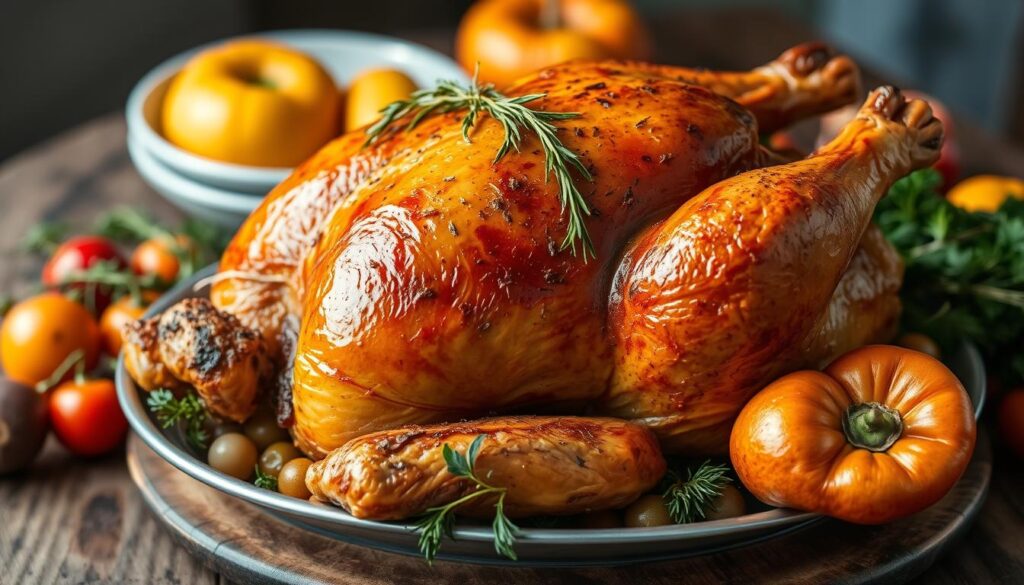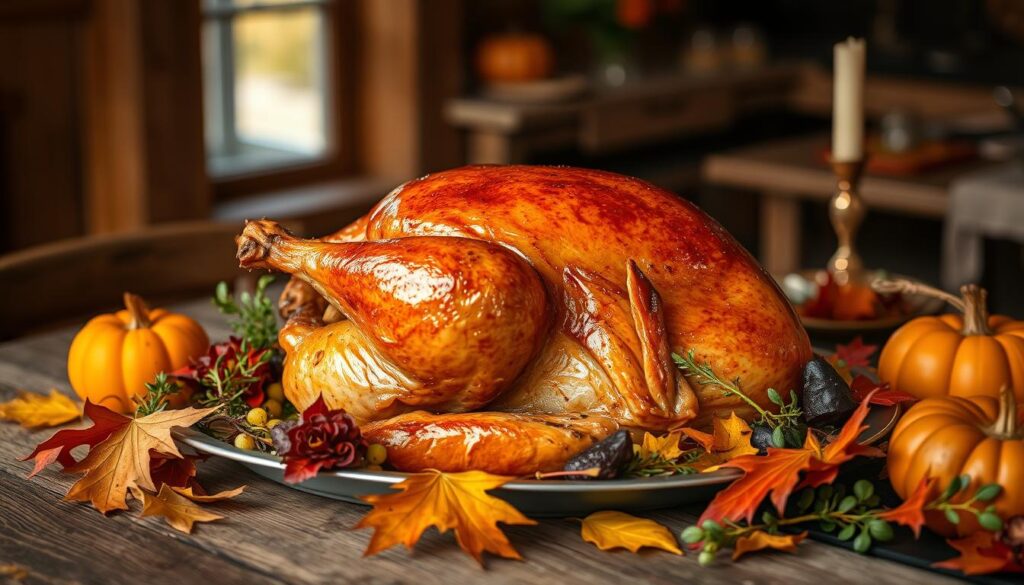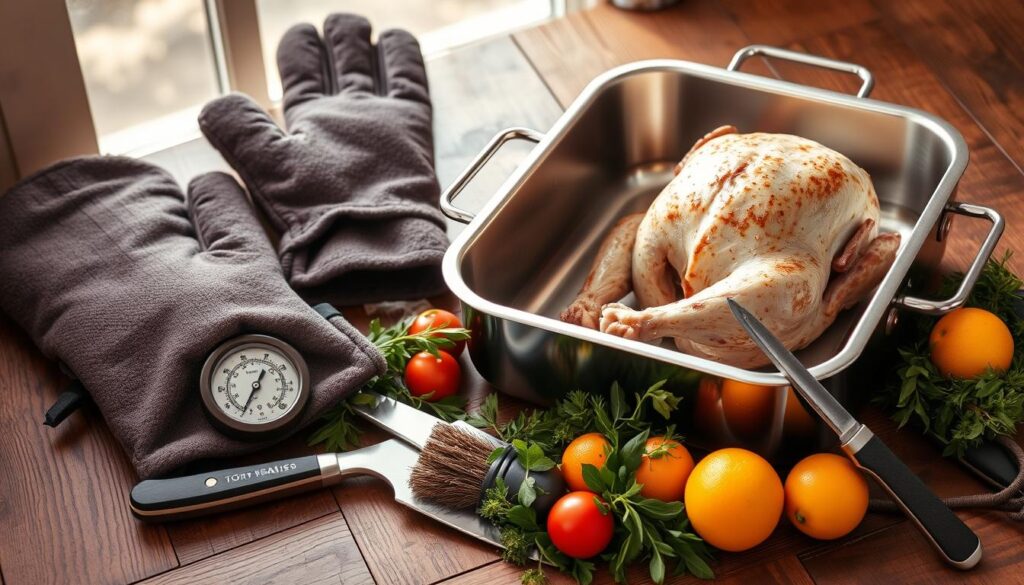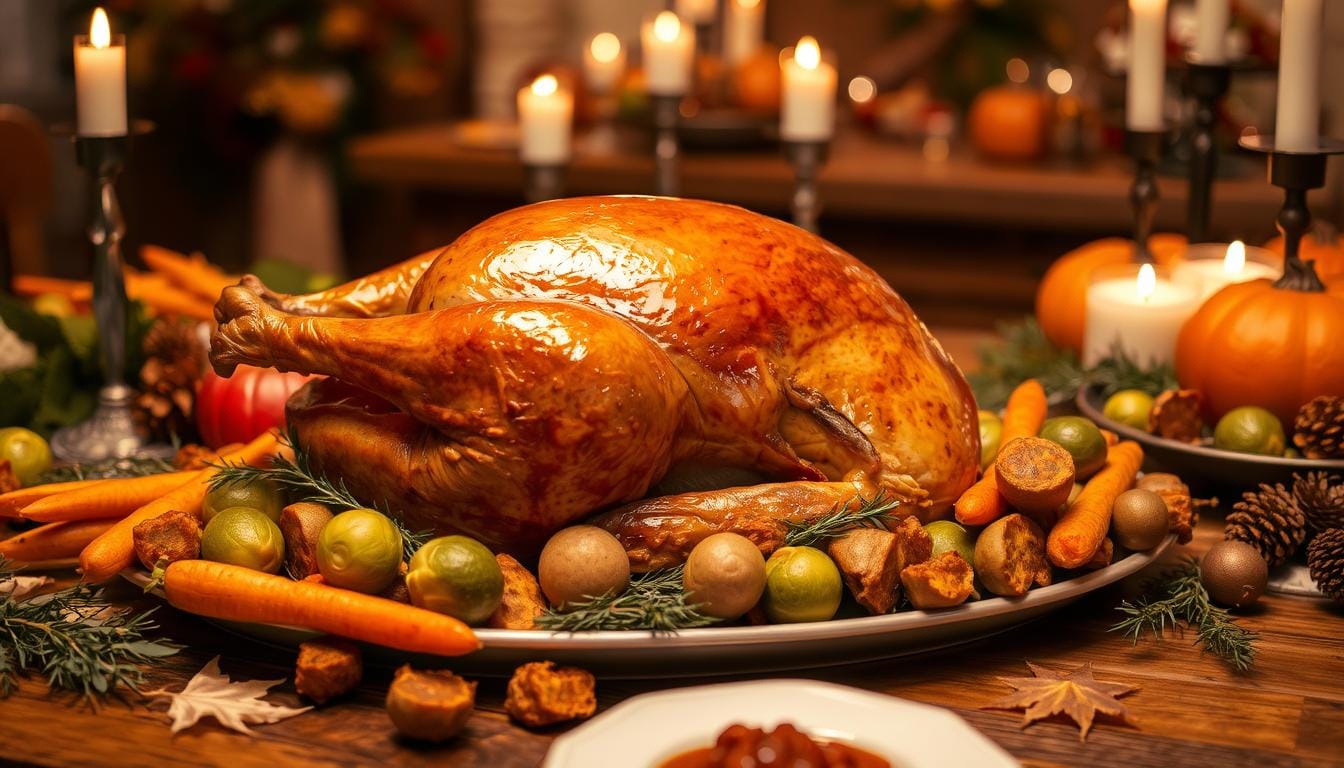Preparing a delicious roast turkey is key for a great Thanksgiving dinner or holiday feast. Whether you’re an experienced host or new to cooking, this guide will show you how. You’ll learn to make a turkey with crispy skin and juicy meat.
The secret to a perfect roast turkey is knowing the basics and making smart choices. We’ll talk about picking the right turkey size, thawing and preparing it, and using the best seasonings and cooking methods. This guide will help you make a standout roast turkey, whether for Thanksgiving or any holiday.
Understanding Roast Turkey Basics
For a perfect roast turkey, a few key factors are important. The turkey should be juicy, flavorful, and have crispy, golden-brown skin. High-quality turkeys from places like Butterball or Norbest usually don’t need a lot of brining to get this right.
But, wild turkeys or heritage breeds might need brining. This helps keep them moist and boosts flavor. To avoid a dry turkey, it’s crucial to not overcook it. Planning and using a meat thermometer are key to getting it just right.
What Makes a Turkey Perfect?
The signs of a perfect roast turkey are:
- Juicy, tender meat that stays moist
- A crisp, golden-brown skin that adds texture and flavor
- A blend of seasonings that enhance the turkey’s taste
- Cooking it just right to prevent drying out
Key Differences Between Turkey Breeds
| Breed | Characteristics | Brining Requirements |
|---|---|---|
| Store-bought (Butterball, Norbest) | Tender, juicy meat | Often don’t require brining |
| Wild turkey | Leaner, more robust flavor | May benefit from brining for moisture and flavor |
| Heritage breeds | Unique, complex flavors | May require brining to enhance tenderness and juiciness |

“The key to a perfect roast turkey is ensuring it doesn’t become overcooked, as that can quickly lead to a dry, lackluster result.”
Choosing the Right Turkey for Your Meal
As Thanksgiving draws near, picking the perfect turkey is key for a great celebration. When selecting your Thanksgiving turkey, consider fresh versus frozen and the right size.
Size Matters: How to Select the Right Weight
The turkey’s size depends on how many guests you’ll have. Aim for 1.5 pounds per person for enough food and leftovers. For a 6-person meal, choose a 10-pound turkey.
When buying a frozen turkey, remember thawing time. Allow one day of thawing in the fridge for every 5 pounds, plus an extra day for safety.

“Choosing the right size turkey is crucial for a successful Thanksgiving feast. Opt for about 1.5 pounds per person to ensure plenty of servings and delectable leftovers.”
Whether you pick fresh or frozen, and any size, thaw the turkey on a cookie sheet. This catches drips and keeps your area clean.
Essential Tools for Roasting Turkey
To make the perfect roast turkey, you need the right tools. You’ll need sturdy roasting pans and reliable meat thermometers. These gadgets help ensure your turkey is moist, flavorful, and beautifully browned. Let’s explore the must-have items for your turkey roasting equipment.
Must-Have Kitchen Gadgets
A high-quality roasting pan is key. Look for one with a curved rack and easy-to-grip handles. A cast-iron skillet is also great for searing, browning, and baking dishes like cornbread or stuffing. For efficient oven use, get a set of half-sheet trays. They’re perfect for roasting vegetables or spatchcocking your turkey for even cooking.
Importance of a Good Meat Thermometer
A reliable instant-read meat thermometer is essential. It ensures your turkey is cooked to the right temperature for safety and taste. A good thermometer, like the Thermapen ONE, gives quick and accurate readings. Use it with an oven thermometer for consistent results.
With the right tools and a good meat thermometer, you’re set to cook the perfect roast turkey. Happy cooking!

| Tool | Recommended Feature | Benefit |
|---|---|---|
| Roasting Pan | Curved rack design, comfortable handles | Improved maneuverability and air circulation for even cooking |
| Cast-Iron Skillet | Versatile for searing, browning, and baking | Ideal for preparing complementary dishes like cornbread or stuffing |
| Half-Sheet Trays | Ample size for roasting vegetables and spatchcocked turkey | Ensures crisp-skinned, evenly cooked results |
| Instant-Read Meat Thermometer | Fast, accurate readings (e.g., Thermapen ONE) | Crucial for determining optimal doneness and food safety |
| Oven Thermometer | Ensures accurate oven temperature calibration | Enables consistent cooking and browning of the turkey |
Preparing Your Turkey for Roasting
To roast your turkey perfectly, you need to follow a few key steps. First, safely thaw your turkey. Then, clean and trim it for roasting.
Thawing Your Turkey Safely
The USDA says to thaw your turkey in the fridge for 24 hours for every 4 to 5 pounds. This slow thaw prevents harmful bacteria from growing. Once thawed, your turkey is ready for cleaning and trimming.
Cleaning and Trimming Techniques
- Remove the turkey from its packaging and discard any plastic wraps or ties.
- Pat the turkey dry with paper towels, taking care to absorb any excess moisture.
- Avoid washing the turkey in the sink, as this can lead to cross-contamination.
- Trim any excess fat or skin around the cavity openings, if desired.
- Tuck the wing tips under the body to prevent them from burning during roasting.
- Optionally, truss the turkey with kitchen twine to help it hold its shape.
By following these steps, your turkey will be ready for roasting. It will be perfectly cooked and look great on your table.
Brining Your Turkey: Is It Necessary?
Your turkey is the star of Thanksgiving. Brining can make it juicier and more flavorful. But do you really need to brine it? Let’s look at the benefits and how to brine your turkey perfectly.
Dry Brining vs. Wet Brining
Brining means soaking the turkey in saltwater before cooking. This makes the meat juicy and full of flavor. There are two ways to brine:
- Dry Brining: Rub the turkey with salt and spices, then refrigerate for 1-3 days. The salt pulls out moisture, which the meat absorbs, seasoning it inside.
- Wet Brining: Submerge the turkey in saltwater for 8-18 hours. This method lets flavors go deeper into the meat.
Flavor Enhancements through Brining
Brining does more than add moisture. It also adds herbs and spices to your turkey flavoring. A basic wet brine might include kosher salt, bay leaves, peppercorns, and citrus. Dry brines can have salt, herbs, and baking powder for crispy skin.
Whether to brine your turkey is up to you. It’s not essential but can make your turkey amazing. It’s worth trying for your holiday meal.
“Brining a turkey is the best way to ensure a moist, flavorful bird every time.”
– Culinary expert, Julia Child
The Right Seasoning for Your Roast Turkey
Perfecting your roast turkey starts with the right seasoning. You can choose classic herb-roasted flavors or create your own. The seasoning you pick can really elevate your dish.
Classic Herb and Spice Blends
For a herb-roasted turkey, try a mix of herbs and spices. Combine unsalted butter, salt, pepper, minced garlic, and fresh herbs like rosemary, thyme, and sage. Rub this mixture under the turkey’s skin for even flavor.
Season the turkey’s cavity with salt and pepper. Stuff it with lemon, onion, apple, and more herbs for extra flavor.
Tailoring Flavors to Your Audience
Want to add your own twist to the turkey seasoning? Try different spice blends. For a Cajun flavor, use paprika, garlic powder, onion powder, cayenne, and oregano. Or, go Mediterranean with lemon zest, oregano, basil, and Dijon mustard.
Remember, you can always experiment. Tailor the flavors to what your guests will love.
“The secret to a perfectly seasoned roast turkey lies in the balance of bold flavors and fragrant herbs.”
Roasting Techniques for Perfect Results
To get a perfect roast turkey, you need to know some techniques. Using a regular oven works well, but trying other methods can make your turkey even better. Let’s look at the main differences between using a regular oven and a convection oven. We’ll also talk about the benefits of rotisserie cooking.
Conventional Oven vs. Convection Oven
The regular oven is a good choice for turkey roasting. It uses radiant heat to cook the turkey, making it golden brown on the outside and juicy inside. But, convection ovens have an edge. They circulate hot air around the turkey, making sure it cooks evenly. This is great for big turkeys, as it helps the thighs and breasts cook at the same time.
Rotisserie Roasting Explained
Rotisserie roasting gives you a unique turkey experience. The turkey is hung on a spit that rotates, basting the meat as it goes. This method makes the turkey brown and evenly cooked. It’s perfect for smaller turkeys, as it prevents the outside from getting too dry while keeping the inside juicy.
No matter the method, the secret to a great turkey is in the prep and details. Preheat your oven to 325°F (165°C). Put the turkey on a rack or veggies, with the breast down. Tuck the wings in and tie the legs with twine. Roast it uncovered, turning it over halfway through. If the breast gets too brown, cover it with foil to stop it from burning.
Learning these roasting techniques will help you make a juicy, perfectly cooked turkey. Your guests will love it and want more.
Cooking Times and Temperatures
Roasting the perfect turkey is all about timing and temperature. Use general guidelines and a meat thermometer to get it right every time.
General Guidelines for Timing
For a turkey, cook at 325°F (165°C) for about 13-15 minutes per pound. The exact time depends on the turkey’s size:
- 8 to 10 pounds: 1 hour 15 minutes to 2 hours
- 10 to 12 pounds: 1 hour 30 minutes to 2 hours 30 minutes
- 12 to 14 pounds: 2 hours to 2 hours 45 minutes
- 14 to 18 pounds: 3 hours 45 minutes to 4 hours 15 minutes
- 18 to 20 pounds: 4 hours 15 minutes to 4 hours 30 minutes
- 20 to 24 pounds: 4 hours 30 minutes to 5 hours
Using a Thermometer to Ensure Safety
Using a meat thermometer is the best way to check if your turkey is cooked. Stick the thermometer into the thickest part of the thigh and breast, avoiding bones. The turkey is ready when it hits 165°F (74°C).
Take the turkey out of the oven when it reaches 160°F (71°C). It will keep cooking a bit after you take it out. Let it rest for at least 30 minutes before carving. This helps keep the juices inside.
“Cooking the Thanksgiving stuffing outside the turkey is recommended for safety. If stuffing the turkey, ensure the center of the stuffing reaches 165°F for safety.”
Preparing Accompaniments and Sides
Hosting a memorable Thanksgiving feast means more than just the turkey. The turkey side dishes you serve can make the meal unforgettable. From classic Thanksgiving sides to creative pairings, there’s endless choice to complement your turkey.
Classic Side Dishes for Roast Turkey
No Thanksgiving is complete without stuffing, mashed potatoes, and gravy. Start with a flavorful cornbread stuffing cooked in a casserole. For mashed potatoes, use 3 pounds of Yukon Gold potatoes, ½ cup of cream, and 4 tablespoons of grated Parmesan cheese. Finish with a rich turkey gravy made from the drippings, neck, and giblets.
Creative Pairings to Impress Guests
- Roasted Brussels sprouts with bacon and balsamic glaze
- Cranberry orange relish with a touch of orange zest
- Creamy green bean casserole with French-fried onions
- Honey-roasted carrots with toasted pecans
These turkey side dishes not only enhance the turkey’s flavor but also add elegance to your feast. With a mix of textures and tastes, your guests will love the effort you put into the pairings.
“The side dishes truly make or break a Thanksgiving meal. They’re the supporting cast that allows the turkey to shine.”
For a successful Thanksgiving, balance traditional favorites with new twists. Offering a variety of Thanksgiving sides ensures your turkey is the star and leaves everyone happy.
Presentation Tips for Your Roast Turkey
The grand finale of your Thanksgiving or Christmas feast is the roast turkey’s presentation. After all the hard work and delicious smells, it’s time to show off your masterpiece. Follow these tips to make your roast turkey the star of the show.
Carving Techniques for Stunning Displays
Let your turkey rest for 20-30 minutes before carving. This step ensures the meat stays moist and full of flavor. Carve the turkey on a large cutting board in a sheet pan to catch drippings. Arrange the slices on a big platter, adding fresh herbs and roasted veggies for a beautiful look.
Serving Suggestions for Elegant Dining
- Use a turkey carving board or platter with a moat to keep juices in.
- Decorate the turkey with fresh rosemary, thyme, or sage, and roasted veggies like Brussels sprouts, carrots, or potatoes.
- Serve the turkey with your favorite gravy, cranberry sauce, and stuffing on the side for a complete holiday table setting.
- Put the turkey and sides on a large, decorative platter for a stunning display.
By focusing on your roast turkey’s presentation, you can turn a tasty meal into a showstopper. It will impress your guests and make your holiday feast unforgettable.
Storing and Reheating Leftover Turkey
After the feast, you’re left with a lot of delicious turkey. It’s important to store and reheat it right to keep it tasty. Follow a few simple steps to enjoy your turkey even after the holiday.
Best Practices for Storage
Keep your leftover turkey fresh by storing it in airtight containers or plastic bags. It will stay good for 3-4 days in the fridge. For longer storage, freeze it in portions for up to 2-3 months. Always reheat it to 165°F (74°C) to kill bacteria.
Delicious Ideas for Leftover Turkey Meals
Don’t waste those leftover turkey pieces! Use them in sandwiches, soups, or casseroles. Shred the meat for enchiladas, pot pies, or tetrazzini. Or, mix it with other leftovers in a salad or sandwich.
To reheat turkey, do it gently. Reheat sliced turkey in the oven at 300°F (150°C) for 20-30 minutes. Or, use the microwave in short bursts. Letting it sit at room temperature before reheating helps it heat evenly.
By following these tips, you can turn leftover turkey into many tasty meals. Enjoy the holiday flavors all year long!
Common Roast Turkey Mistakes to Avoid
Preparing the perfect roast turkey can seem tough, but it’s easier than you think. One big mistake is overcooking the turkey, making it dry and tough. Using only the “pop-up” timers on some turkeys can be misleading, as they’re not always accurate.
Pitfalls That Can Ruin Your Turkey
Not using a meat thermometer is another common error. It’s best to check the turkey’s internal temperature by inserting the thermometer into the thickest part of the thigh. This ensures it reaches a safe 165°F. Stuffing the turkey can also be risky, as the stuffing’s temperature might not hit 165°F.
Tips to Ensure Success Every Time
To cook a turkey perfectly, don’t keep opening the oven door. This can mess with the temperature and make the turkey cook longer. Use a digital thermometer to keep track of the turkey’s progress. Also, don’t baste the turkey too much, as it can affect the cooking time.
Lastly, let the turkey rest for at least 15 minutes before carving. This helps keep the juices inside, making the meat moist and flavorful.
FAQ
What makes a turkey perfect?
A perfect turkey is juicy, flavorful, and has crispy skin. Store-bought turkeys like Butterball or Norbest often don’t need brining. Wild turkeys might need it for moisture and flavor.
The key to perfection is not overcooking. This can dry out the meat.
How much turkey should I buy?
Buy about 1.5 pounds of turkey per person for leftovers. For a 6-person meal, get at least a 10 lb turkey. Thaw frozen turkey in the fridge for one day for every 5 pounds, plus an extra day for safety.
What essential tools do I need?
You’ll need a roasting pan or a large casserole dish, a meat thermometer, and kitchen twine. An instant-read digital thermometer is key for checking doneness. A disposable foil roasting pan is a budget-friendly option.
Should I brine my turkey?
Brining is optional for store-bought turkeys but recommended for wild turkeys. Use a food-grade, nonreactive container for brining. A simple brine recipe includes kosher salt and cold water.
Brine the turkey for 12 hours or overnight in the refrigerator. Rinse thoroughly before cooking if wet brined.
How do I prepare the turkey for roasting?
Thaw the turkey in the refrigerator, allowing 24 hours for every 5 pounds. Remove it from the fridge 1 hour before roasting to bring it to room temperature. Don’t wash the turkey to avoid contaminating your sink.
Instead, remove it from packaging, pat dry with paper towels, and prepare for the oven.
What’s the best way to season the turkey?
Create an herb butter with unsalted butter, salt, pepper, minced garlic, and fresh herbs like rosemary, thyme, and sage. Rub this mixture under the skin and all over the turkey.
Season the cavity with salt and pepper. Stuff with quartered lemon, onion, apple, and fresh herbs for added flavor.
How long should I roast the turkey?
Roast at 325°F (165°C) for about 13-15 minutes per pound. Check internal temperature in the thickest part of the thigh and breast; it should reach 165°F (74°C).
Start checking halfway through estimated cooking time. Remove turkey at 160°F (71°C) and tent with foil; it will continue cooking to reach 165°F (74°C).
What are some common mistakes to avoid?
Common mistakes include overcooking, not using a thermometer, and stuffing the turkey. Avoid basting, which can lead to temperature fluctuations and longer cooking times.
Don’t truss the legs too tightly, as this can prevent even cooking. Always let the turkey rest before carving to retain juices and ensure moist meat.

